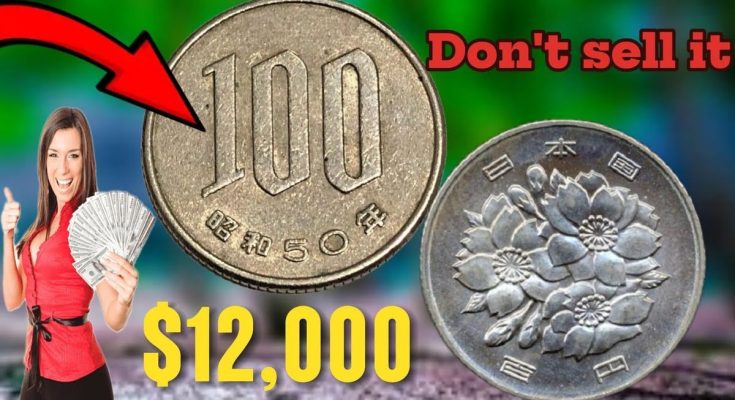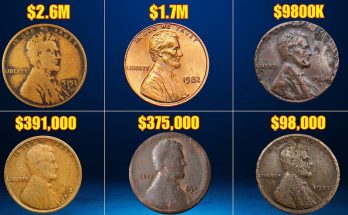🌸 100 YEN COIN WORTH THOUSANDS! VALUABLE Japanese Coin Finds You Must Look For
The world of numismatics is full of sleeper coins—pieces that look ordinary on the surface but hide an extraordinary value due to a specific year, a unique feature, or a tiny minting error. The image above, showing a familiar Japanese 100 Yen coin alongside a stunning valuation of $12,000, is the perfect illustration of this collector’s dream. While your everyday 100 Yen coin from the Heisei or Reiwa eras (post-1989) is worth its face value, there are specific, key-date Japanese coins that command massive prices at auction.
To find a true treasure among the yen, collectors need to look for three main categories of rarity: Silver Coins, Key Dates/Low Mintages, and Mint Errors.
💎 Category 1: The Silver Standard (The Original 100 Yen)
The most immediate high-value find within the 100 Yen denomination are the older, silver issues. The modern 100 Yen coin shown in the image is copper-nickel, introduced in 1967 (Shōwa Year 42). However, before this date, the 100 Yen coin was composed of 60% Silver.
-
The Phoenix (1957-1958, Shōwa 32-33): The earliest version of the 100 Yen featured the Phoenix (Hō-ō) design. These silver coins are highly sought after by collectors, not just for their historical significance but for their intrinsic silver content.
-
The Rice Sheaves (1959-1966, Shōwa 34-41): The design shown in the coin catalogs (a sheaf of rice) succeeded the Phoenix. While they are still common enough in circulated condition to be valued primarily for their silver melt value (typically in the $5 to $10 range depending on silver price), a pristine, uncirculated roll or a perfectly preserved example from a key low-mintage year can be worth much more. A circulated example would easily be one of the most valuable “100 Yen” coins you could pull from your change today.
The Lesson: Always check the dates on older Japanese coinage. If you find a 100 Yen coin from before 1967, you’ve found silver, and you must Don’t sell it until you have researched its true value.
📅 Category 2: Key Dates and Commemoratives
In the world of Japanese coins, value often comes down to mintage numbers, and some years saw incredibly low production, making the coins instantly rare. The Japanese calendar system, based on the reigning Emperor’s era, makes dating a crucial first step.
-
Heisei Era (1989-2019): Look for low-mintage years. For instance, the 100 Yen coins from Heisei 13 (2001) and Heisei 14 (2002) have some of the lowest mintages for circulation 100 Yen coins of the modern era, with only around 7.7 million and 10.4 million struck, respectively. While not worth $12,000, uncirculated examples of these specific dates can sell for many times their face value.
-
The 1964 Tokyo Olympics (Shōwa 39) 100 Yen: While a commemorative, this coin is important because it was made of 60% silver, making it instantly valuable beyond its face amount. These are very popular collectible pieces.
🔨 Category 3: The True $12,000 Treasures – Minting Errors
The extreme valuation of $12,000 as shown in the photo’s caption would likely point to a coin that is a true numismatic anomaly—a significant error coin or a specific, extremely rare issue. While these discoveries are incredibly rare, they are the finds that transform average people into wealthy collectors overnight.
One type of error that has created million-yen coins in Japan is the “Mule” coin, where the obverse and reverse designs from two different coins are accidentally paired together on a single planchet. Other high-value errors include:
-
Major Die Errors: Coins struck with a doubled die, causing a noticeable doubling of the lettering or design elements.
-
Off-Metal Strikes: Coins struck on the incorrect metal composition. For example, a 100 Yen coin accidentally struck on a planchet intended for a smaller denomination.
-
Proof/Specimen Errors: Extremely low-mintage proof coins (specially struck for collectors) that sometimes escape into circulation or exhibit a unique error.
The Collector’s Takeaway
The modern 100 Yen coin is typically worth its currency equivalent. But if you have an interest in Japanese history and a keen eye for detail, you must remember these three pointers:
-
Check the Date: Look for the Shōwa era (coins from the 1950s and 60s, which may be silver) or the low-mintage Heisei dates (specifically Heisei 13 and 14).
-
Check the Metal: Anything before 1967 should feel heavier and look different—that’s the silver you’re looking for.
-
Check for Errors: Any noticeable misalignment, missing letters, or weird-looking metal color could signify a valuable minting error.
DO NOT SELL IT before you have a rare Japanese coin professionally graded. Certification from a respected third-party grading service, like NGC or PCGS, is essential to confirm authenticity and unlock the potential thousands in value.
Would you like me to search for the specific Japanese date (Shōwa 50年) on the coin in the photo to check its mintage and current market value?



